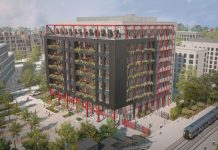Employees are proving keen to return to the office, reporting that they miss the human and social interaction that the office facilitates. At the same time, while employees show a strong affinity for the office, they also desire the ability to have the option to work from home 1-2 days per week on average according to a recent JLL global study of 3,000 workers. The trend towards workplace mobility was not created as a result of the pandemic, but it was certainly accelerated by it. As a result, agile work strategies are expected to increase in a post-pandemic world, reinvigorating demand for flexible space.
A new JLL report, the impact of COVID-19 on flexible space, outlines the future of flexible space both now and long after the pandemic subsides. The report indicates that flexible space will take a different form than it has in the past, but will continue to grow as corporates and investors alike respond to the increasing demand for flexibility. In fact, JLL research still predicts that 30 percent of all office space will be consumed flexibly by 2030.
As more companies adopt increasingly distributed corporate ecosystems, flexibility will be key to employee satisfaction as the office remains a fundamental part of corporate culture. According to JLL’s Occupancy Benchmarking Survey, 67 percent of real estate decision makers are increasing workplace mobility programs, while only 4 percent indicated they would be contracting those programs.
“Office space will continue to evolve as a result of the pandemic and is arguably going to play an even greater role in driving corporate well-being and productivity,” said Ben Munn, Global Flexible Space Lead for JLL. “As organizations look to adapt to the ‘next normal’ where de-densification of main office space will need to occur, we anticipate a move towards a ‘hubs and clubs’ model that provides office locations closer to where people live. These distributed locations, or ‘clubs,’ are likely to lean heavily on flexible space arrangements.”
Over the last decade, the experience-led office design movement, which combined mobility with flexibility, manifested into the dramatic rise of coworking and flexible space – which also increased density. While the densities recorded pre-COVID will likely be reduced, at least temporarily, the demand drivers that led to the flexible space boom are still intact. These trends will be compounded by organizations’ unwillingness to assume long-term lease liabilities and commit to large capex projects, therefore opting for pre-built spaces with lease flexibility.
“We expect to see a fundamental shift in the way office space is consumed,” said Alex Colpaert, Head of Office Research, EMEA, JLL. “Coworking operators have experienced a dramatic boom-bust cycle, and COVID presents some unique challenges for the industry, but the future of real estate will retain many of the key elements that helped fuel this disruption. Space will be fast, flexible and fun. Pre-built spaces, agile design, technology integration, flexible lease terms and hospitality services will become the norm and continue to transform commercial real estate from a commodity to a consumer product.”
While the ability to work from home is becoming seamlessly integrated into working life, maintaining productivity away from the office can be difficult over the long term and living arrangements can often make working from home a less than optimal choice. Corporate perceptions have shifted away from office real estate as purely a static expense toward it being a strategic driver of transformation and employee performance. There is a sustained, long-term employee appetite for purposefully designed office space, with safety and well-being at its core, as part of an increasingly integrated, liquid and flexible real estate strategy.
A greater focus on spaces which emphasize collaboration is also likely to emerge as office space is redesigned and repurposed. As tenants return to their offices, business continuity and operational resilience will be top priorities – and since flexible space is fast and easy to acquire, companies are likely to turn to flex solutions to support portfolio reductions and cost-saving strategies during this time of economic uncertainty.
“The office has long provided a place for concentrated work and is increasingly becoming a place for collaboration, connection, innovation and social interaction. The desire for these characteristics has not diminished. In a revived post-pandemic market where adaptability is high on the corporate agenda and the purpose of the ‘hub’ office is centered around collaboration, flexible space demand and growth will return to its impressive pre-COVID rates,” added Munn.



















